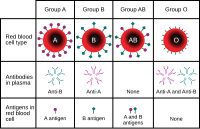
Photo from wikipedia
PURPOSE To assess the visual prognosis of optic neuritis (ON) in dependence of the glial autoimmune antibody status and associated factors. DESIGN Longitudinal observational cohort study METHODS: : Patients with… Click to show full abstract
PURPOSE To assess the visual prognosis of optic neuritis (ON) in dependence of the glial autoimmune antibody status and associated factors. DESIGN Longitudinal observational cohort study METHODS: : Patients with ON and measurements of serum concentrations of glial autoantibodies were consecutively and longitudinally examined with a minimal follow-up of three months. Patients with multiple sclerosis and double seronegative results were excluded. RESULTS The study included 529 patients (aquaporin-4 immunoglobulin (AQP4-IgG) seropositive,n=291;myelin oligodendrocyte glycoprotein immunoglobulin (MOG-IgG) seropositive,n=112;double-seronegative,n=126) with 1022 ON episodes (AQP4-IgG seropositive,n=550;MOG-IgG seropositive,n=254;double-seronegative,n=218). Prevalence of severe vision loss (best-corrected visual acuity (BCVA) ≤20/200 at the end of follow-up) was higher (P<0.001) in the AQP4-IgG group (236/550;42.9%) than in the seronegative group (68/218;31.2%) and in the MOG-IgG group (15/254;5.9%). Prevalence of good vision recovery (BCVA≥20/40) was higher (P<0.001) in the MOG-IgG group (229/254;90.2%) than in the seronegative group (111/218:50.9%) and in the AQP4-IgG group (236/550;42.9%). In multivariable logistic analysis, higher prevalence of severe vision loss was associated with AQP4-IgG seropositivity (odds ratio (OR):1.66;95% confidence interval (CI):1.14,2.43;P=0.008), male sex (OR:1.97;95%CI:1.33,2.93;P<0.001), age at ON onset >45 years (OR:1.93;95%CI:1.35,2.77;P<0.001), nadir vision ≤20/200 (OR:14.11;95%CI:6.54,36.93;P<0.001) and higher number of recurrences (OR:1.35;95%CI:1.14,1.61;P=0.001). Higher prevalence of good vision outcome was associated with MOG-IgG seropositivity (OR:8.13;95%CI:4.82,14.2;P<0.001), age at ON onset <18 years (OR:1.78;95%CI:1.18,2.71;P=0.006), nadir visual acuity ≥20/40 (OR:4.03;95%CI:1.45,14.37;P=0.015) and lower number of recurrences (OR:0.60;95%CI:0.50,0.72;P<0.001). CONCLUSION Severe vision loss (prevalence in the AQP4-IgG group, MOG-IgG group and seronegative group:42.9%,5.9%, and 31.2%, respectively) was associated with AQP4-IgG seropositivity, male gender, older age at onset, worse nadir vision, and higher number of recurrences.